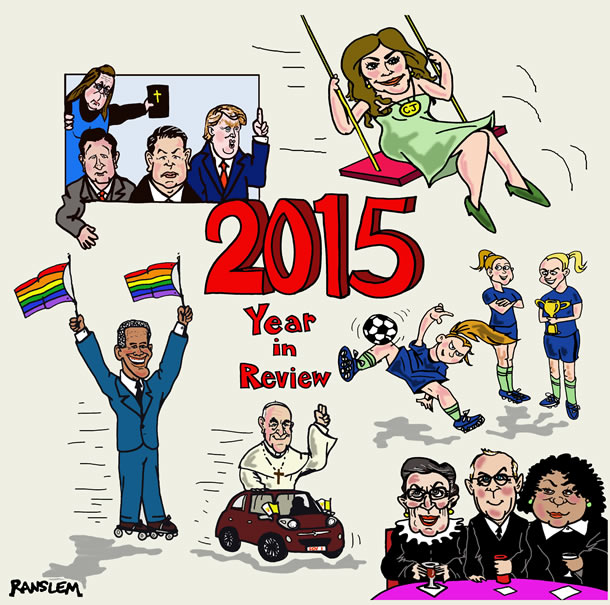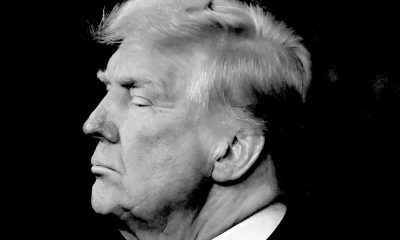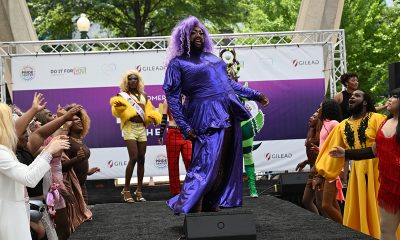a&e features
The year’s biggest A&E moments
Caitlyn, ‘Carol,’ ‘Stonewall’ and more
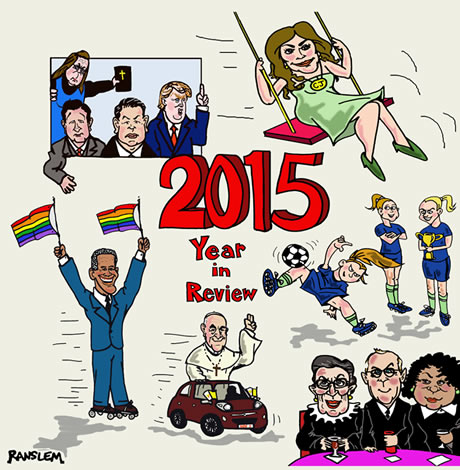
#10 Neil Patrick Harris just so-so at the Oscars
After successful stints hosting the Tonys and Emmys, expectations were high in February when long-time out actor Neil Patrick Harris hosted the 87th Academy Awards, becoming the first openly gay man (Ellen hosted the year before) to take on the tough assignment.
Showing off a remarkably fit physique, he lampooned a scene from “Birdman” by appearing on stage in tighty-whities, a move that drew mixed reviews. The New York Times said overall he was “bland.” Time said he was “glum and low energy.”
Viewership was down 16 percent, the lowest rating in six years according to Variety. Harris told Huffington Post later he doubts he’ll ever do it again.
“I don’t know that my family nor my soul could take it,” he said in that interview.
After a white-hot run of successes in recent years, Harris fumbled in 2015. His fall NBC show “Best Time Ever with Neil Patrick Harris,” a live TV variety series, was cancelled in December after just eight episodes.
#9 Return of Madonna and Janet
In March, Madonna released her 13th studio album “Rebel Heart.” Despite a massive leak, it debuted solidly at No. 2 on Billboard (121,000 units) and received generally better reviews than her previous two releases. Her “Rebel Heart Tour” opened in September with strong reviews and sales.
Janet Jackson returned in October with her 11th album “Unbreakable,” her first new studio project in seven years. With 116,000 units, the album was No. 1 on the Billboard albums chart the week it debuted and garnered strong reviews. The “Unbreakable World Tour” kicked off in August in Vancouver with several fast sell-outs. After taking December off, she goes back out Jan. 9 in Denver and plays Baltimore on Feb. 29 and D.C. on March 1. It’s her first tour since 2011 and marks a return to arenas after playing smaller venues last time.
Despite the buzz and media interest, U.S. radio continued to mostly ignore the singers. On the Hot 100, a chart the two dominated in the ‘80s and ‘90s, Janet’s first single “No Sleeep” made it only to No. 67. She found more success on the Adult R&B chart, where the single spent a record 10 weeks at No. 1. The title cut was the second single and didn’t chart. Neither did Madonna’s first single “Living for Love” or second single “Ghost Town.” Both singers had some success (Madge always manages a No. 1 dance hit for practically everything she releases) on other Billboard charts. Madonna’s third single “Bitch I’m Madonna” peaked at No. 84 on the Hot 100.
#8 ‘Hamilton’ hits big on Broadway
With a score “rooted in hip-hop but also encompassing R&B, jazz, pop, Tin Pan Alley and the choral strains of contemporary Broadway,” as the New York Times put it, “Hamilton,” which opened on Broadway in August, is this year’s monster hit where it’s turned the notion of the “Great White Way” on its head with a cast of mostly black and Latino actors playing the founding fathers.
Based on a 2004 biography of Alexander Hamilton, the show has drawn raves for its ability to “redefine what an American musical can look and sound like,” as the Times wrote.
Out actor Jonathan Groff plays King George III, a nice change of pace for him after HBO’s “Looking” ended its second and last season in March.
#7 ‘Transparent’ goes through the roof
“Transparent,” the hit Amazon Studios show that tells of Maura Pfefferman’s (Jeffrey Tambor) transition process and the effect it has on her family, went through the roof this year.
In addition to the Golden Globe for Best Television Series — Musical or Comedy (the first time a streamed show has taken this award) Tambor also won a Globe and later an Emmy as well.
The show’s second season premiered in December. It’s been renewed for a third. It has an impressive 98 percent freshness rating on critical roundup site Rotten Tomatoes.
#6 ‘Glee’ signs off
Although it wound down with more of a whimper than a bang, “Glee,” the hit Fox series that debuted in 2009 and told of the ups and downs of the William McKinley High School glee club, the show, created by Ryan Murphy, Brad Falchuk and Ian Brennan, deserves praise for its brave handling of LGBT issues.
From out cast members Jane Lynch, Chris Colfer and Alex Newell to its sensitive handling of LGBT storylines, the show was an awards magnet winning four GLAAD Media Awards for Outstanding Comedy Series, six Emmys, four Golden Globes and a bounty of other accolades.
Ratings had fallen steadily in recent years after a second season high.
#5 Danny Pintauro comes out as HIV positive
Although he’d been out of the pop culture limelight, former “Who’s the Boss?” and “Cujo” actor Danny Pintauro, who’d been out for years, told Oprah on an episode of her show “Oprah: Where Are They Now?” in September that he’s been HIV positive for 12 years.
Although initially embraced for his candor, Pintauro later drew criticism for saying on “The View” that he believes he contracted the virus through oral sex, a possibility HIV experts said was highly unlikely.
He later told the Blade at the AIDS Walk in October — he was on hand to accept an award — that he didn’t mean he knew that definitively but that it was his “best guess” as to how he contracted HIV.
#4 ‘Stonewall’ tanks
In August when the public got its first look at “Stonewall,” this year’s dramatization of the 1969 New York LGBT riots from director Roland Emmerich (“Independence Day”), the trailer was widely trashed for slickly whitewashing the watershed moment for gay rights.
Upon its September release, critical consensus was extremely negative in both the gay and mainstream press with a wide spate of reviews condemning the filmmaker’s decision to center the events around a fictional hunky white character (played by straight actor Jeremy Irvine) and reducing trans women and people of color to the sidelines.
Although Emmerich said he was intrigued by the issue of LGBT youth homelessness, a Vanity Fair critic said he managed to take “one of the most politically charged periods of the last century” and make it into a “bland, facile coming-of-age story.” Some activists called for an LGBT boycott of the movie.
The film cost about $17 million to make with part of it self-financed by Emmerich. It bombed at the box office. According to IMDB, its U.S. gross as of October was just short of $200,000.
#3 Big year for LGBT film
There’ve always been LGBT movies but even just a few years ago, most of the gay content was in smaller indie fare with a token mainstream release like “Brokeback Mountain” here or there. That is no longer the case.
With “Freeheld,” the Julianne Moore project about a woman’s fight to have her pension benefits transferred to her domestic partner after being diagnosed with terminal cancer; to “The Danish Girl,” the Eddie Redmayne vehicle that finds him starring as trans pioneer Lili Elbe; to “Carol,” the Todd Haynes-helmed film based on a Patricia Highsmith novel, LGBT themes in major films were no longer token occurrences.
#2 U.S. women’s soccer team out and proud
When the U.S. beat Japan in July to take the 2015 FIFA Women’s World Cup, the international women’s football (i.e. soccer) world championship, it was not just a triumph for the United States women’s national soccer team, the tournament was a watershed moment for out athletes with 18 publicly out players on the field for various countries including the U.S.’s Jillian Ellis (coach), Ali Krueger, Megan Rapinoe and Abby Wambach.
“While the men’s professional game has been reluctant to be fully inclusive and supportive of anyone within the game who identifies as LGBT, it’s generally regarded that football is much more accepting of women who are lesbian or bisexual,” said Lindsay England, head of Just a Ball Game, an organization that works to end anti-LGBT bias in soccer, in an Out Sports interview.
Wambach, who treated media interest in her 2013 marriage to Sarah Huffman bemusedly, retired in
December with too many accolades and wins to count, including two Olympic gold medals and a ranking in this year’s Time magazine’s 100 most influential people of the year.
#1 The world meets Caitlyn Jenner
It was in many ways the year of Cait and few would argue she is anything but the most prominent transgender person in the country.
The Olympic champion who found a second wind of fame as patriarch of reality show “Keeping Up with the Kardashians,” came out officially as transgender in an April Diane Sawyer interview on ABC’s “20/20” and was first seen as Caitlyn in a lavish cover story and fashion spread in the July issue of Vanity Fair.
Her (what else?) reality show “I Am Cait” debuted over the summer on E! and has been renewed for a second season (no premiere date for season two announced yet). It’s enjoyed decent if hardly rapturous ratings and reviews and has been noted for a more serious tone than that of the “Kardashians.”
Jenner’s long-held Republican views, especially her half-hearted endorsement of same-sex marriage for one, have induced winces on several occasions from LGBT activists. After speaking at a luncheon in Chicago in November, Jenner — camera crew in tow — was confronted by an angry mob of trans protesters who said she was a “disgrace.” Their basic beef was that the 65-year-old Cait has enjoyed such a life of privilege that she could never fully understand their plight. To her credit, Jenner engaged them.
In an early episode of her show, she seemed to grasp the import of her role and said, “I just hope I get it right.”
a&e features
Doug Spearman takes his chance
‘Noah’s Arc: The Movie’ debuted on Paramount+ last month
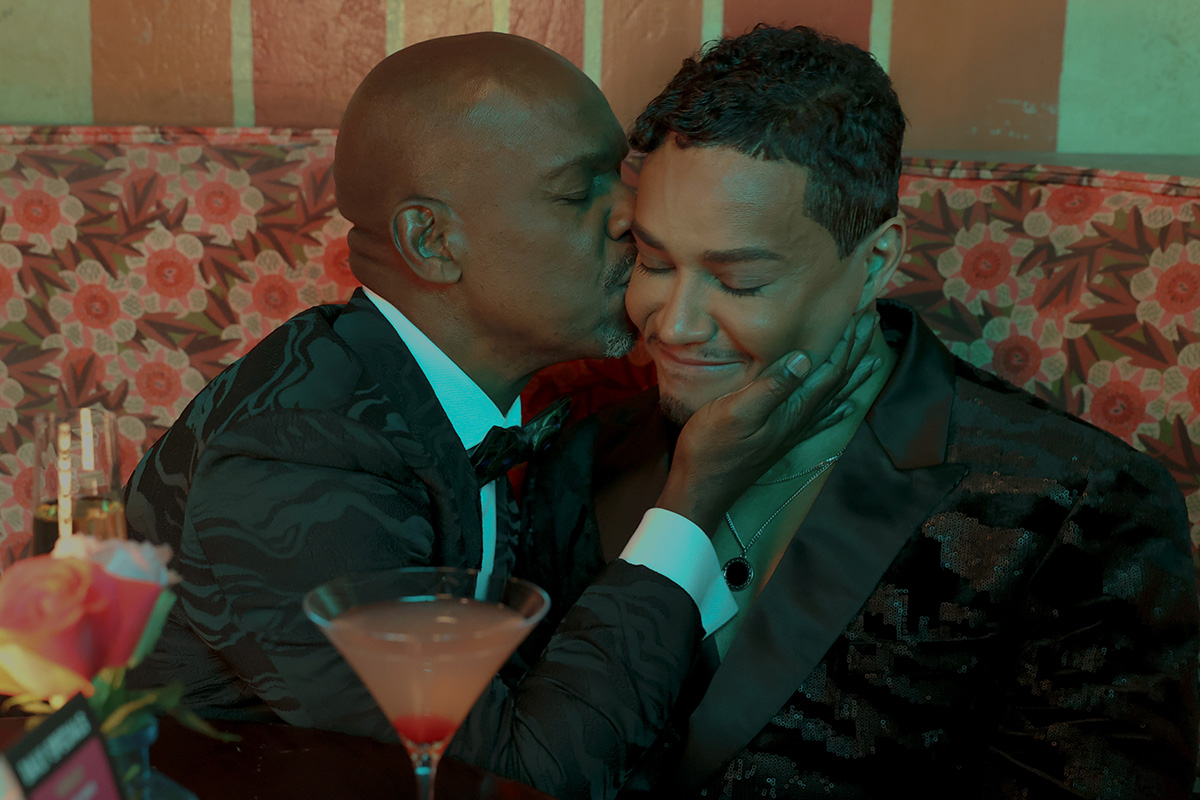
There’s no question that when Patrik-Ian Polk’s series “Noah’s Arc” premiered on Logo 20 years ago, it was a groundbreaking creation. The story of a group of Black gay men and their wonderful friendship. The titular arc was that of the cute main character, Noah (Darryl Stephens), and his close-knit circle of friends, including Chance played by gay actor Doug Spearman. This compelling and loving fraternity may, in fact, be what brought viewers back repeatedly, including a 2008 movie, “Noah’s Arc: Jumping the Broom,” as well as the 2020 “Noah’s Arc” short, and now, a new full-length feature “Noah’s Arc: The Movie,” debuting on Paramount+ on June 20. In the movie, filled with equal measures of laughs and tears, Chance, who has faced a devastating loss, finds his dependable friends there, ready to support and comfort him at a moment’s notice. I had the pleasure of speaking with Spearman the morning of the streaming premiere of “Noah’s Arc: The Movie.”
WASHINGTON BLADE: Doug, since the early 2000s, when the “Noah’s Arc” series premiered on Logo, you have been playing the character of Chance, including in the latest installment, “Noah’s Arc: The Movie.” What was it about Chance that appealed to you as an actor?
SPEARMAN: When Patrik (-Ian Polk) called me to ask me to play him (Chance), I was at JFK airport in the baggage claim, waiting for a suitcase. He explained what the part was. The thing that stuck out to me was the fact that Chance was in a long-term relationship with another Black man. And, they had a child; they had a 4-year-old daughter named Kenya. I had never seen two Black gay men raise a child on TV before. I thought it was the most revolutionary thing I’d ever seen. I immediately thought I’ve got to do this because that was something nobody had seen. I thought it was incredibly important to take the part.
BLADE: “Noah’s Arc: The Movie” was, once again, written and directed by Patrik-Ian Polk, who you just mentioned, is the creator of the entire franchise. What’s the secret to your long-standing working relationship?
SPEARMAN: [Laughs] the whole team, all of us, are like a band of brothers. We fight like brothers, we come together like brothers, we hash things out, we talk, because we’re all very different from our characters. I think the challenge of playing these guys and then uplifting these men, playing a part, especially something written by Patrik, is like solving a math equation. There’s always a challenge that’s enjoyable for me as an actor: to try to find out what it is that Patrik wants, and then how do I do it.
BLADE: I think you do a very good job of it.
SPEARMAN: Thank you very much
BLADE: In the years between “Jumping the Broom” and the new full-length movie, many changes have occurred, and the story addresses some of them, including gay widowhood, which is something that the aging community is now confronting, as well as mental health issues. Please say a few words about how you approached those subjects in the new movie.
SPEARMAN: I had a lot of loss in my life, right before we started shooting. Two months before we started shooting the first series, my mother died. I was going through the grief process through that whole first season. Since then, I’ve lost a lot of people in my life. In fact, when we started shooting the second season, the second week we were shooting, my ex died of a heart attack. I was having to fold that into what I was doing with my life on the set and off the set. You’ve got to show up and you’ve got to do your work. The first two seasons of “Noah’s Arc” are always tinged with the memory of grief. So, when I had to deal with the death that Chance faces (in the new movie), which is a significant death in his life, it wasn’t that hard to reach back, especially the scene in the graveyard. It was something that I unfortunately could pull from personal experience.
BLADE: Shifting gears, the movie features delightful cast surprises, including Jasmine Guy and TS Madison. Did you have a chance to interact with either or both when they were on set?
SPEARMAN: No, I didn’t have any scenes with Jasmine, and I missed her. I wish I had gotten to see her because I actually got to direct Jasmine for a CBS promo shoot for “Queen,” back in the early ‘90s. I had a huge crush on her when she was on “A Different World.” So, I really would have liked to reconnect. But TS and I got to see each other every day because I was in all her scenes. It was extraordinary being around somebody like that. That is one outspoken woman!
BLADE: Even though Beyoncé never makes an appearance in the movie, there’s a lot of talk about her. Would you say you are a Beyoncé fan?
SPEARMAN: Yes! I’m breathing! Yes, I’m a Beyoncé fan. I actually got the chance to meet her. I knew her mom. Her mom was extraordinary to me. She is in the second movie I directed. She also gave us a wedding gown to use in the very first scene of the movie. That family is extraordinarily important to me. Not only just to be a fan, but to be somebody who’s gotten to know them and work with them and see how hard they work. I don’t think anybody works as hard as Tina or Beyoncé.
BLADE: There was a recent news item about gay actor Benito Skinner of the Amazon Prime series “Overcompensating” being told not to bother auditioning for straight roles. As an out actor yourself, how important do you think it is for queer characters to be portrayed by queer actors, and vice versa?
SPEARMAN: Being queer is a multifaceted identity. There’s no one kind of queer person. I think finding the best actor that’s your first circle of casting. I think one of the joys about being an actor is that you get to play different parts. I play straight guys all the time. Dads and husbands and things like that. I think a lot of people are told not to do it. In fact, I wouldn’t be Chance if the actor who was originally cast as Chance hadn’t been pulled out of the series by his agents because they didn’t want him to play a gay character.
BLADE: That’s amazing! Thank you for sharing that. Without giving away too much, the ending of the movie is a little ambiguous, even ending with a question mark. If there was a “Noah’s Arc: The Movie” sequel, would you come back for that?
SPEARMAN: Yeah! A lot of it would depend on what Chance’s journey is going to be like. Patrik and I have conversations like that all the time. He’s very interested and supportive of input. I hope I would be, as we all would be, part of the creative growth with these characters. They live in Patrik’s head, and he writes them, but we’re the ones who have to flesh them out. It’s a conversation, it’s always a conversation.
BLADE: You are currently performing in Molière’s “The Imaginary Invalid” as part of the New Orleans Shakespeare Festival at Tulane. What has this experience been like for you?
SPEARMAN: It’s extraordinary! I started on stage when I was seven. There’s nothing like working with a live audience and having that immediacy. I’m working with an extraordinarily talented cast in a really great play, and I have some of the best scene partners I could ever want.
BLADE: Are there any upcoming film or TV projects you’d like to mention?
SPEARMAN: I’m still a writer, and I’m still a director, and I’ve still got scripts that I would like to make. I have a little something that’s a cross between “Treme” and “Bridgerton” that I want to do. I’m always trying to figure out what the next thing is.
a&e features
Visit Cambridge, a ‘beautiful secret’ on Maryland’s Eastern Shore
New organization promotes town’s welcoming vibe, LGBTQ inclusion
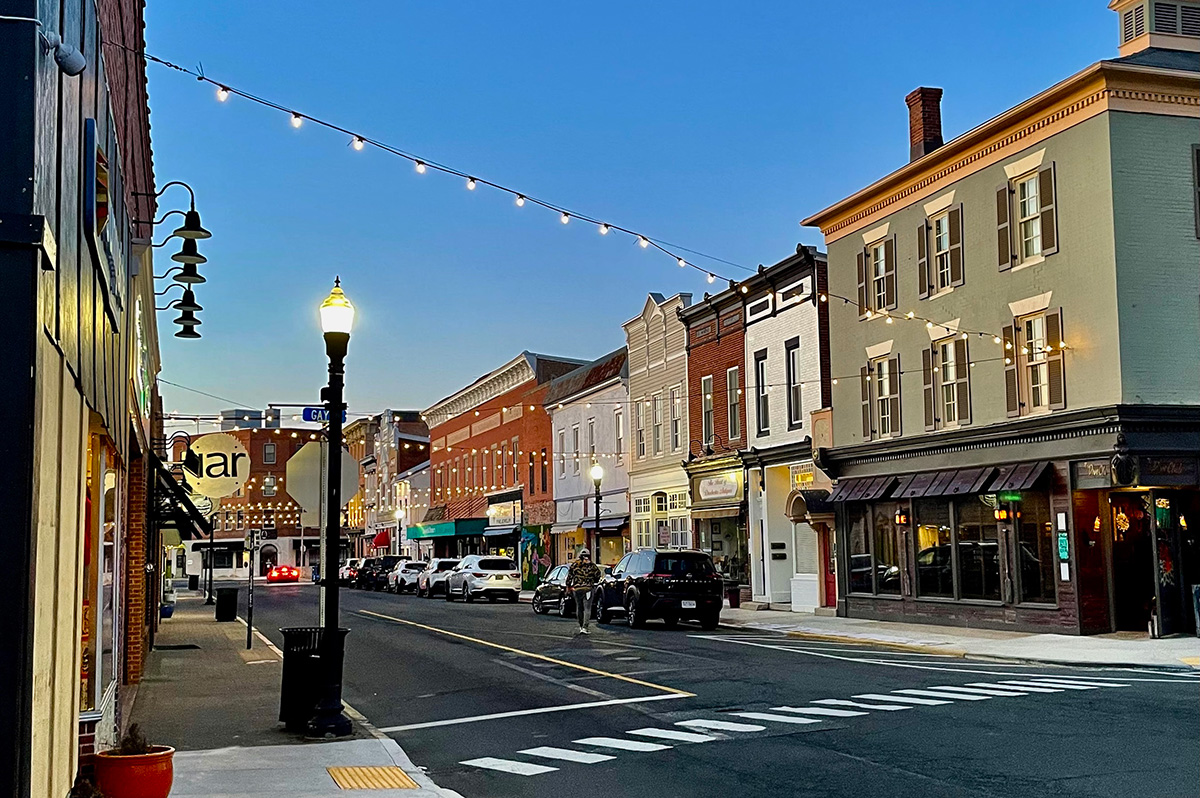
CAMBRIDGE, Md. — Driving through this scenic, historic town on Maryland’s Eastern Shore, you’ll be charmed by streets lined with unique shops, restaurants, and beautifully restored Victorian homes. You’ll also be struck by the number of LGBTQ Pride flags flying throughout the town.
The flags are a reassuring signal that everyone is welcome here, despite the town’s location in ruby red Dorchester County, which voted for Donald Trump over Kamala Harris by a lopsided margin. But don’t let that deter you from visiting. A new organization, Proudly Cambridge, is holding its debut Pride event this weekend, touting the town’s welcoming, inclusive culture.
“We stumbled on a beautiful secret and we wanted to help get the word out,” said James Lumalcuri of the effort to create Proudly Cambridge.
The organization celebrates diversity, enhances public spaces, and seeks to uplift all that Cambridge has to share, according to its mission statement, under the tagline “You Belong Here.”
The group has so far held informal movie nights and a picnic and garden party; the launch party is June 28 at the Cambridge Yacht Club, which will feature a Pride celebration and tea dance. The event’s 75 tickets sold out quickly and proceeds benefit DoCo Pride.
“Tickets went faster than we imagined and we’re bummed we can’t welcome everyone who wanted to come,” Lumalcuri said, adding that organizers plan to make “Cheers on the Choptank” an annual event with added capacity next year.
One of the group’s first projects was to distribute free Pride flags to anyone who requested one and the result is a visually striking display of a large number of flags flying all over town. Up next: Proudly Cambridge plans to roll out a program offering affirming businesses rainbow crab stickers to show their inclusiveness and LGBTQ support. The group also wants to engage with potential visitors and homebuyers.
“We want to spread the word outside of Cambridge — in D.C. and Baltimore — who don’t know about Cambridge,” Lumalcuri said. “We want them to come and know we are a safe haven. You can exist here and feel comfortable and supported by neighbors in a way that we didn’t anticipate when we moved here.”
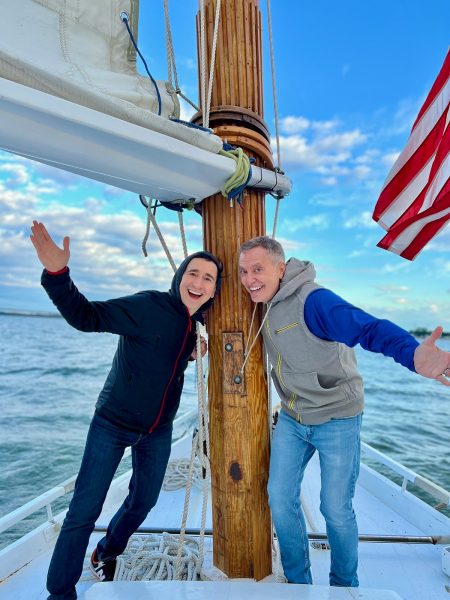
Lumalcuri, 53, a federal government employee, and his husband, Lou Cardenas, 62, a Realtor, purchased a Victorian house in Cambridge in 2021 and embarked on an extensive renovation. The couple also owns a home in Adams Morgan in D.C.
“We saw the opportunity here and wanted to share it with others,” Cardenas said. “There’s lots of housing inventory in the $300-400,000 range … we’re not here to gentrify people out of town because a lot of these homes are just empty and need to be fixed up and we’re happy to be a part of that.”
Lumalcuri was talking with friends one Sunday last year at the gazebo (affectionately known as the “gayzebo” by locals) at the Yacht Club and the idea for Proudly Cambridge was born. The founding board members are Lumalcuri, Corey van Vlymen, Brian Orjuela, Lauren Mross, and Caleb Holland. The group is currently working toward forming a 501(c)3.
“We need visibility and support for those who need it,” Mross said. “We started making lists of what we wanted to do and the five of us ran with it. We started meeting weekly and solidified what we wanted to do.”
Mross, 50, a brand strategist and web designer, moved to Cambridge from Atlanta with her wife three years ago. They knew they wanted to be near the water and farther north and began researching their options when they discovered Cambridge.
“I had not heard of Cambridge but the location seemed perfect,” she said. “I pointed on a map and said this is where we’re going to move.”
The couple packed up, bought a camper trailer and parked it in different campsites but kept coming back to Cambridge.
“I didn’t know how right it was until we moved here,” she said. “It’s the most welcoming place … there’s an energy vortex here – how did so many cool, progressive people end up in one place?”
Corey van Vlymen and his husband live in D.C. and were looking for a second home. They considered Lost River, W.Va., but decided they preferred to be on the water.
“We looked at a map on both sides of the bay and came to Cambridge on a Saturday and bought a house that day,” said van Vlymen, 39, a senior scientist at Booz Allen Hamilton. They’ve owned in Cambridge for two years.
They were drawn to Cambridge due to its location on the water, the affordable housing inventory, and its proximity to D.C.; it’s about an hour and 20 minutes away.
Now, through the work of Proudly Cambridge, they hope to highlight the town’s many attributes to residents and visitors alike.
“Something we all agree on is there’s a perception problem for Cambridge and a lack of awareness,” van Vlymen said. “If you tell someone you’re going to Cambridge, chances are they think, ‘England or Massachusetts?’”
He cited the affordability and the opportunity to save older, historic homes as a big draw for buyers.
“It’s all about celebrating all the things that make Cambridge great,” Mross added. “Our monthly social events are joyful and celebratory.” A recent game night drew about 70 people.
She noted that the goal is not to gentrify the town and push longtime residents out, but to uplift all the people who are already there while welcoming new visitors and future residents.
They also noted that Proudly Cambridge does not seek to supplant existing Pride-focused organizations. Dorchester County Pride organizes countywide Pride events and Delmarva Pride was held in nearby Easton two weeks ago.
“We celebrate all diversity but are gay powered and gay led,” Mross noted.
To learn more about Proudly Cambridge, visit the group on Facebook and Instagram.
What to see and do
Cambridge, located 13 miles up the Choptank River from the Chesapeake Bay, has a population of roughly 15,000. It was settled in 1684 and named for the English university town in 1686. It is home to the Harriet Tubman Museum, mural, and monument. Its proximity to the Blackwater National Wildlife Refuge makes it a popular stop for birders, drawn to more than 27,000 acres of marshland dubbed “the Everglades of the north.”
The refuge is walkable, bikeable, and driveable, making it an accessible attraction for all. There are kayaking and biking tours through Blackwater Adventures (blackwateradventuresmd.com).
Back in town, take a stroll along the water and through historic downtown and admire the architecture. Take in the striking Harriet Tubman mural (424 Race St.). Shop in the many local boutiques, and don’t miss the gay-owned Shorelife Home and Gifts (421 Race St.), filled with stylish coastal décor items.
Stop for breakfast or lunch at Black Water Bakery (429 Race St.), which offers a full compliment of coffee drinks along with a build-your-own mimosa bar and a full menu of creative cocktails.
The Cambridge Yacht Club (1 Mill St.) is always bustling but you need to be a member to get in. Snapper’s on the water is temporarily closed for renovations. RaR Brewing (rarbrewing.com) is popular for craft beers served in an 80-year-old former pool hall and bowling alley. The menu offers burgers, wings, and other bar fare.
For dinner or wine, don’t miss the fantastic Vintage 414 (414 Race St.), which offers lunch, dinner, wine tasting events, specialty foods, and a large selection of wines. The homemade cheddar crackers, inventive flatbreads, and creative desserts (citrus olive oil cake, carrot cake trifle) were a hit on a recent visit.
Also nearby is Ava’s (305 High St.), a regional chain offering outstanding Italian dishes, pizzas, and more.
For something off the beaten path, visit Emily’s Produce (22143 Church Creek Rd.) for its nursery, produce, and prepared meals.
“Ten minutes into the sticks there’s a place called Emily’s Produce, where you can pay $5 and walk through a field and pick sunflowers, blueberries, you can feed the goats … and they have great food,” van Vlymen said.
As for accommodations, there’s the Hyatt Regency Chesapeake Bay (100 Heron Blvd. at Route 50), a resort complex with golf course, spa, and marina. Otherwise, check out Airbnb and VRBO for short-term rentals closer to downtown.
Its proximity to D.C. and Baltimore makes Cambridge an ideal weekend getaway. The large LGBTQ population is welcoming and they are happy to talk up their town and show you around.
“There’s a closeness among the neighbors that I wasn’t feeling in D.C.,” Lumalcuri said. “We look after each other.”
a&e features
James Baldwin bio shows how much of his life is revealed in his work
‘A Love Story’ is first major book on acclaimed author’s life in 30 years
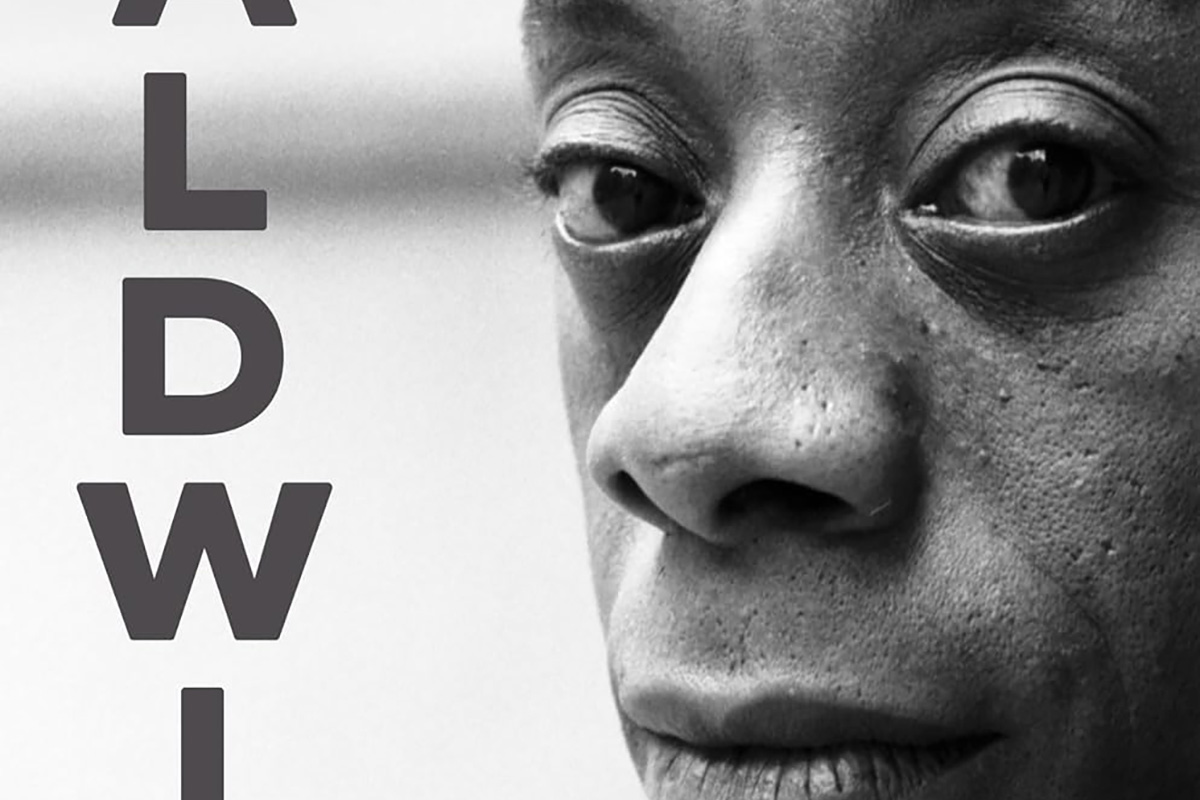
‘Baldwin: A Love Story’
By Nicholas Boggs
c.2025, FSG
$35/704 pages
“Baldwin: A Love Story” is a sympathetic biography, the first major one in 30 years, of acclaimed Black gay writer James Baldwin. Drawing on Baldwin’s fiction, essays, and letters, Nicolas Boggs, a white writer who rediscovered and co-edited a new edition of a long-lost Baldwin book, explores Baldwin’s life and work through focusing on his lovers, mentors, and inspirations.
The book begins with a quick look at Baldwin’s childhood in Harlem, and his difficult relationship with his religious, angry stepfather. Baldwin’s experience with Orilla Miller, a white teacher who encouraged the boy’s writing and took him to plays and movies, even against his father’s wishes, helped shape his life and tempered his feelings toward white people. When Baldwin later joined a church and became a child preacher, though, he felt conflicted between academic success and religious demands, even denouncing Miller at one point. In a fascinating late essay, Baldwin also described his teenage sexual relationship with a mobster, who showed him off in public.
Baldwin’s romantic life was complicated, as he preferred men who were not outwardly gay. Indeed, many would marry women and have children while also involved with Baldwin. Still, they would often remain friends and enabled Baldwin’s work. Lucien Happersberger, who met Baldwin while both were living in Paris, sent him to a Swiss village, where he wrote his first novel, “Go Tell It on the Mountain,” as well as an essay, “Stranger in the Village,” about the oddness of being the first Black person many villagers had ever seen. Baldwin met Turkish actor Engin Cezzar in New York at the Actors’ Studio; Baldwin later spent time in Istanbul with Cezzar and his wife, finishing “Another Country” and directing a controversial play about Turkish prisoners that depicted sexuality and gender.
Baldwin collaborated with French artist Yoran Cazac on a children’s book, which later vanished. Boggs writes of his excitement about coming across this book while a student at Yale and how he later interviewed Cazac and his wife while also republishing the book. Baldwin also had many tumultuous sexual relationships with young men whom he tried to mentor and shape, most of which led to drama and despair.
The book carefully examines Baldwin’s development as a writer. “Go Tell It on the Mountain” draws heavily on his early life, giving subtle signs of the main character John’s sexuality, while “Giovanni’s Room” bravely and openly shows a homosexual relationship, highly controversial at the time. “If Beale Street Could Talk” features a woman as its main character and narrator, the first time Baldwin wrote fully through a woman’s perspective. His essays feel deeply personal, even if they do not reveal everything; Lucian is the unnamed visiting friend in one who the police briefly detained along with Baldwin. He found New York too distracting to write, spending his time there with friends and family or on business. He was close friends with modernist painter Beauford Delaney, also gay, who helped Baldwin see that a Black man could thrive as an artist. Delaney would later move to France, staying near Baldwin’s home.
An epilogue has Boggs writing about encountering Baldwin’s work as one of the few white students in a majority-Black school. It helpfully reminds us that Baldwin connects to all who feel different, no matter their race, sexuality, gender, or class. A well-written, easy-flowing biography, with many excerpts from Baldwin’s writing, it shows how much of his life is revealed in his work. Let’s hope it encourages reading the work, either again or for the first time.

